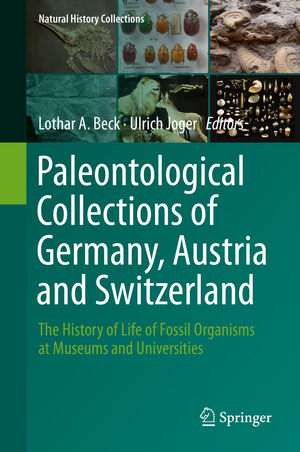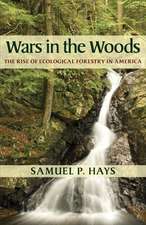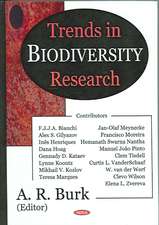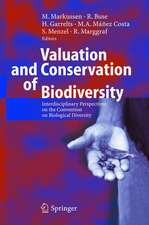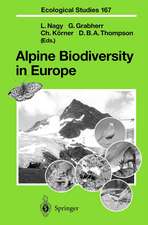Paleontological Collections of Germany, Austria and Switzerland: The History of Life of Fossil Organisms at Museums and Universities: Natural History Collections
Editat de Lothar A. Beck, Ulrich Jogeren Limba Engleză Hardback – 27 noi 2018
The approach employed by the editors involves not only an introduction to the paleontological collections in general, but also information on the international and national collection networks. Particular attention is given to new exhibition concepts and approaches of sorting, preserving and researching in paleontological collections and also their neglect and/or threat. In addition, the book provides information on all big public museums, on important state museums and regional Museums, and also on university collections.
This is a highly informative and carefully presented book, providing scientific insight for readers with an interest in fossil record, biodiversity, taxonomy, or evolution, as well as natural history collections at large.
Preț: 1845.48 lei
Preț vechi: 2250.58 lei
-18% Nou
Puncte Express: 2768
Preț estimativ în valută:
353.15€ • 371.34$ • 291.79£
353.15€ • 371.34$ • 291.79£
Carte disponibilă
Livrare economică 27 martie-10 aprilie
Preluare comenzi: 021 569.72.76
Specificații
ISBN-13: 9783319774008
ISBN-10: 331977400X
Pagini: 600
Ilustrații: XIII, 573 p. 380 illus., 342 illus. in color.
Dimensiuni: 155 x 235 mm
Greutate: 1.27 kg
Ediția:1st ed. 2018
Editura: Springer International Publishing
Colecția Springer
Seria Natural History Collections
Locul publicării:Cham, Switzerland
ISBN-10: 331977400X
Pagini: 600
Ilustrații: XIII, 573 p. 380 illus., 342 illus. in color.
Dimensiuni: 155 x 235 mm
Greutate: 1.27 kg
Ediția:1st ed. 2018
Editura: Springer International Publishing
Colecția Springer
Seria Natural History Collections
Locul publicării:Cham, Switzerland
Cuprins
Research and open questions – a modern concept behind Berlins T. rex presentation of Tristan Otto.- Scientific Methods of Geological and Paleontological Collections and Trends in Paleontological Investigation and Research.- BAMBERG: The paleontological collection at the Museum of Natural History in Bamberg (NKMB) .- BASEL: The Natural History Museum Basel (NMB)..- BERLIN: The palaeontological collections of the Museum für Naturkunde Berlin.- BERN: The Natural History Museum Bern – an Institution of the Burgergemeinde of Bern.- BIELEFELD: Not worth mentioning? Paleontological collections of small museums: the example of Bielefeld (Noth Rhine Westphalia, Germany).- BILZINGSLEBEN: The Bilzingsleben collection.- BRAUNSCHWEIG: The Paleontological Collection of the State Museum of Natural History (SNHM) in Braunschweig, Germany.- BREMEN: The paleontological research collection of the Geosciences Collection of the University of Bremen.- CHEMNITZ: Back to the roots of palaeobotany – Chemnitz and its palaeontological collection.- COBURG: Naturkunde-Museum Coburg - Paleontological collections.- COTTBUS: Museum of Natural History and Environment in Cottbus.- DARMSTADT: The paleontological collections of Hessisches Landesmuseum Darmstadt.- DESSAU: Museum of Natural History and Prehistory Dessau: Paleontological Collection.- DORTMUND: Museum für Naturkunde der Stadt Dortmund.
Textul de pe ultima copertă
This book is devoted to 250 years of collecting, organizing and preserving paleontological specimens by generations of scientists. Paleontological collections are a huge resource for modern research and should be available for national and international scientists and institutions, as well as prospective public and private customers. These collections are an important part of the scientific enterprise, supporting research, public education, and the documentation of past biodiversity. Much of what we are beginning to understand about our world, we owe to the collection, preservation, and ongoing study of natural specimens. Properly preserved collections of fossil marine or terrestrial plants and animals are archives of Earth's history and vital to our ability to learn about our place in its future.
The approach employed by the editors involves not only an introduction to the paleontological collections in general, but also information on the international and national collection networks. Particular attention is given to new exhibition concepts and approaches of sorting, preserving and researching in paleontological collections and also their neglect and/or threat. In addition, the book provides information on all big public museums, on important state museums and regional Museums, and also on university collections.
This is a highly informative and carefully presented book, providing scientific insight for readers with an interest in fossil record, biodiversity, taxonomy, or evolution, as well as natural history collections at large.
This is a highly informative and carefully presented book, providing scientific insight for readers with an interest in fossil record, biodiversity, taxonomy, or evolution, as well as natural history collections at large.
Caracteristici
Contains a detailed overview on paleontological natural history collections in Germany, Austria, and Switzerland Summarizes the latest trends in paleontological methods of sorting and preserving Provides an overview on modern exhibition concepts at paleontological natural history museums
